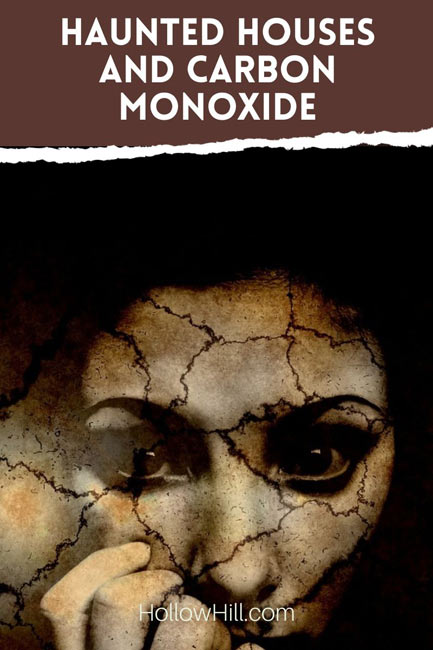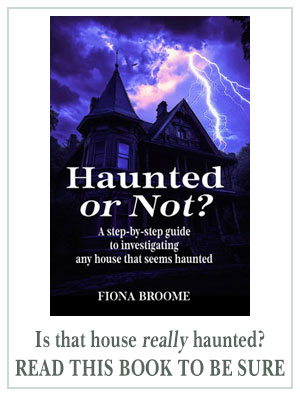As an Amazon Associate I earn from qualifying purchases. Click for details.
How can carbon monoxide affect a haunted house?
When people contact me about a house that might have ghosts, they often say things like:
 “Sometimes, when I’m in that part of the house, I get shaky, dizzy, and I feel weak all over.”
“Sometimes, when I’m in that part of the house, I get shaky, dizzy, and I feel weak all over.”- “I get a tightness in my chest, and I can’t catch my breath. Do you suppose the ghost died of a heart attack?”
- “I’m okay during the day, but at night – especially when it’s cold out – it’s like something floats into my room through the bedroom window, and I can’t breathe.”
- “The baby gets fussy in that room and seems to be looking at something that I don’t see, and the dog won’t go in there, ever.”
- “I’m fine all day, but at night, when we close up the house and go to bed, I get headaches, it feels really stuffy in the room, and sometimes I feel kind of sick. I always have to get up and open the window, just to feel the breeze. About an hour or two later, around midnight, everything’s fine again.”
Well, those “symptoms” of a haunting can be caused by carbon monoxide poisoning. That’s why carbon monoxide is now the first thing to check in a house that might be haunted. This is especially true if the ghosts started to be a problem when the house was sealed up for the winter, or – in warm climates – for the summer.
The following is an edited excerpt from the first edition of, Is Your House Haunted?, by Fiona Broome.
Before you do anything else…
Check the carbon monoxide levels at the possibly-haunted site.
Carbon monoxide is nicknamed “the silent killer.” Pets and children often react to it first. Carbon monoxide (CO), also called carbonous oxide, is a colorless, odorless and tasteless gas.
It is highly toxic to humans and animals in higher quantities.
It can come from a variety of sources, including gas appliances, woodstoves, car exhaust, blocked flues, and even cigarette smoke.
Some people are more sensitive to carbon monoxide, and may show symptoms before others do.
Any of the following symptoms may indicate high levels of carbon monoxide.
- Headaches.
- A tight sensation in the chest.
- Nausea.
- Shortness of breath.
- Vomiting.
- Dizziness.
- Fatigue.
- A feeling of weakness.
- Confusion or disorientation.
- Visual disturbances.
- Fainting and seizures.
- Flu symptoms.
- Infants may be irritable.
- Pets can avoid certain areas.
Carbon monoxide can also affect the heart and central nervous system, and raise blood pressure. Carbon monoxide poisoning can damage the fetus of a pregnant woman.
Many areas in the UK, the US, and Canada have laws recommending (or even requiring) the use of carbon monoxide detectors in homes.
Older homeowners may not realize that. Even if the homeowner has no fireplace or woodstove, and no gas appliances, check the levels anyway.
For example, if a nearby neighbor has a wood stove and you (or the client) sleep with your window open, elevated carbon monoxide could explain some “symptoms” of a haunting.
If you regularly investigate haunted sites, be sure your home has very low levels of carbon monoxide, too.
If you’ve been sensitized to the gas, even low levels might trigger your symptoms at a “haunted” site. It could happen. Rule this out, immediately.
When you’re investigating a potentially haunted house and any symptoms match the warning list, carbon monoxide levels must be checked first.
If the homeowner does not have a carbon monoxide detector installed, and you don’t have a handheld monitor, call the fire department for advice.
Note: Before buying a handheld carbon monoxide meter, be sure to read the reviews.
If you’re investigating haunted homes and you can’t afford a good carbon monoxide detector, don’t bother with a cheap one. Either have the homeowner install carbon monoxide detectors in several places in the home – and use them for at least a week before you investigate – or ask the fire department if someone in the community can test the air for the homeowner.
A carbon monoxide meter that works is important. A cheap one that’s not reliable could put you and your client at risk.
So, either use a good detector or have the homeowner or someone else handle that part of the investigation.


informative
i heard a story on youtube and started searching whether its true or not. And yes! is true.
thank you for providing such information